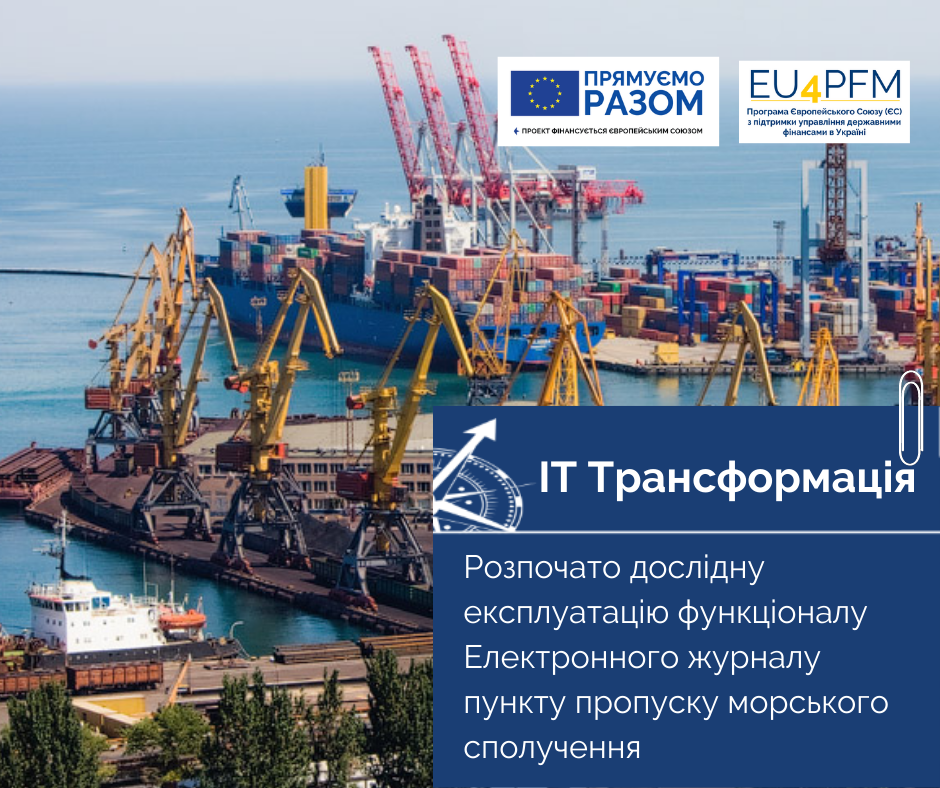Experimental operation of the functionality of the Electronic Journal of the maritime checkpoint
On June 10, the trial operation of the Electronic Journal of the Seaport Checkpoint (Journal), one of the components of the updated Automated Customs Clearance System (ASMO), which will also provide the foundation for the operation of the Smart Checkpoint in seaports, began in June. The introduction of the Journal into the work of the State Customs Service should allow automating customs clearance at maritime checkpoints, simplifying and speeding up the process of customs control of foreign vessels.

“In Ukraine, there is currently no single electronic system of the register of maritime vehicles for customs purposes, the processes of control procedures at maritime checkpoints are not automated, there is no automatic exchange of information between customs and entities on calls. And even during the customs control of foreign vessels no automated risk management system used. The introduction of the Electronic Journal of the maritime checkpoint should centralize and synchronize the work of all structural units of Customs, “said Mr. Eugene Entis, Deputy Head of the State Customs Service for Digital Development, Digital Transformations and Digitization.
In general, it is expected that as a result of the introduction of the Electronic Journal of the maritime checkpoint will be provided:
– acceptance / processing / storage of court documents in electronic form
– transfer of decisions to the participants of the port community from the customs in electronic format
– automation of procedures in the process of customs control of vessels crossing the border of Ukraine
– logging of actions of the inspector during customs control
– control over the re-import / export of foreign vessels
– automation of risk assessment during control procedures for the vessel
– receiving / storing data on loading containers from the vessel containers
– receiving / storing batches.
According to Ms. Daria Shulyakova, an EU4PFM expert, three electronic registers will be tested during the trial operation – ship records, container accounting and order accounting. For experimental operation in the port of Odessa will be implemented 3 most common scenarios that will check the functionality and get comments from direct users of the system:
Registration of departure of a foreign vessel with an overdue obligation to re-import (export), including basic work with documents and formalities
Full cycle of registration of a foreign vessel: arrival and departure, with the imposition of obligations and closing without delay, including the processing of extraordinary situations: sending for revision, cancellation of formalities and cancellation of the mark.
The full cycle of registration of a Ukrainian vessel to verify the work with the obligation.
This is the 1st stage of functionality. The next stages of functional development will automate the work with general declarations of arrival, scale the use of the Electronic Journal of the sea checkpoint to all ports of Ukraine, as well as ensure accounting and customs control of goods crossing the border at sea checkpoints and transported in containers. After the experimental operation and grinding of the functional, it is planned to pilot in the Odessa customs for 3 months; after that, a decision will be made on the possibility of deploying the functionality at the national level.
As you know, the reform of Customs involves the introduction of new IT solutions to modernize services and processes of its work – IT transformation. IT transformation of Customs provides for 6 main areas: “Cabinet of interaction with Customs”, “Customs control and clearance”, “Public reporting and analytics”, “Smart checkpoint”, “Cybersecurity”, “Harmonization with the EU”. These areas are also part of the e-Customs project – one of the digitization projects provided for in the Resolution of the Cabinet of Ministers. They are expected to be implemented by the end of 2022.
Creation of “Journals of checkpoints” (maritime, automobile) is provided by the direction “Customs control and registration”.

